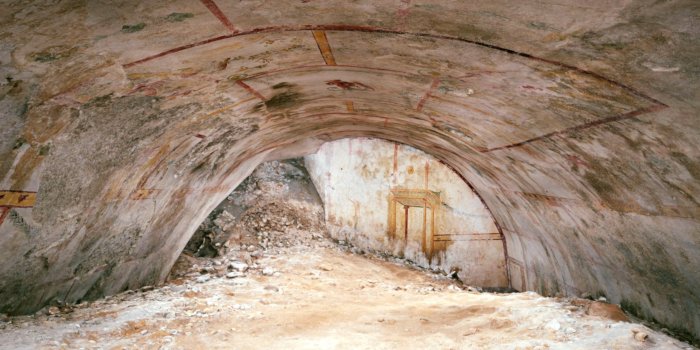


He also began a pool, extending from Misenum to the lake of Avernus, roofed over and enclosed in colonnades, into which he planned to turn all the hot springs in every part of Baiae a canal from Avernus all the way to Ostia, to enable the journey to be made by ship yet not by sea its length was to be a hundred and sixty miles and its breadth sufficient to allows ships with five banks of oars to pass each other. When the edifice was finished in this style and he dedicated it, he deigned to say nothing more in the way of approval than that he was at last beginning to be housed like a human being. He had baths supplied with sea water and sulphur water. The main banquet hall was circular and constantly revolved day and night, like the heavens. There were dining-rooms with fretted ceils of ivory, whose panels could turn and shower down flowers and were fitted with pipes for sprinkling the guests with perfumes. In the rest of the house all parts were overlaid with gold and adorned with gems and mother-of‑pearl. There was a pond too, like a sea, surrounded with buildings to represent cities, besides tracts of country, varied by tilled fields, vineyards, pastures and woods, with great numbers of wild and domestic animals. Its vestibule was large enough to contain a colossal statue of the emperor a hundred and twenty feet high and it was so extensive that it had a triple colonnade a mile long. Its size and splendour will be sufficiently indicated by the following details. He made a palace extending all the way from the Palatine to the Esquiline, which at first he called the House of Passage, but when it was burned shortly after its completion and rebuilt, the Golden House. There was nothing however in which he was more ruinously prodigal than in building. Suetonius describes the scale and opulence of the Domus: Artists including Michelangelo and Raphael translated what they had seen in the Domus Aurea to their own work, especially their frescoes found in Vatican City. When a Roman teenager stumbled upon the Domus Aurea in the late 15th century, the early Italian Renaissance artists were quick to study the illustrations on the ceilings and walls of the house. As for the 120-foot statue of Nero, its face was changed and actually moved by Hadrian to outside the Flavian Amphitheater. Seen as an embarrassment to Nero’s successors, the Domus Aurea was stripped of all its marble, jewels and ivory within the decade after Nero’s death. The palace and the grounds were filled with earth, and soon the Baths of Trajan, the Baths of Titus, and the Coliseum were to be built over the house. After Nero’s suicide in 68 AD, the new emperor Vespasian gave the land back to the public. The construction of the palace was actually never finished. One of the most impressive spaces was the Octagon Room, which supposedly included a mechanism that, when operated by a team of slaves, would make the ceiling in the dome of room revolve like the heavens. This made Nero quite popular with average Roman citizens. The house was used quite often for parties (thrown by Nero), as there were many open spaces and rooms for the common people to use. According to Tacitus’ Annals, Nero was quite involved in the design of the Domus Aurea, and actually oversaw Celer and Severus’ work to make sure every detail was just right. It is rumored that this statue of Nero resembled later depictions of Sol, the Roman sun god.Ĭeler and Severus were the two architects commissioned for the construction of the ornate palace. This statue was designed to imitate the Colossus of Rhodes. Nero commissioned a 120-foot bronze statue of his likeness to be built by the entrance to the palace. The Great Fire however allowed Nero to rebuild and extend the grounds of his palace, which would now include the rest of the Palatine Hill, the Caelian Hill, as well as space in the valley between the two hills. Prior to the Great Fire, Nero’s Palace was known as the Domus Transitoria, or the House of Passage, and ranged from the Palatine Hill to the Esquiline Hill. Seutonius claimed in The Life of Nero that: The new palace featured areas such as forests, a man-made lake (which was large enough to fit battleships used for performances), and vineyards. Nero Claud Caesar Aug Ger P M Tr P ImpĬommissioned by the Roman Emperor Nero to be built after the Great Fire of Rome in 64 AD, the Domus Aurea, or Golden House, was an extremely lavish palace, whose grounds covered approximately a square mile.


 0 kommentar(er)
0 kommentar(er)
